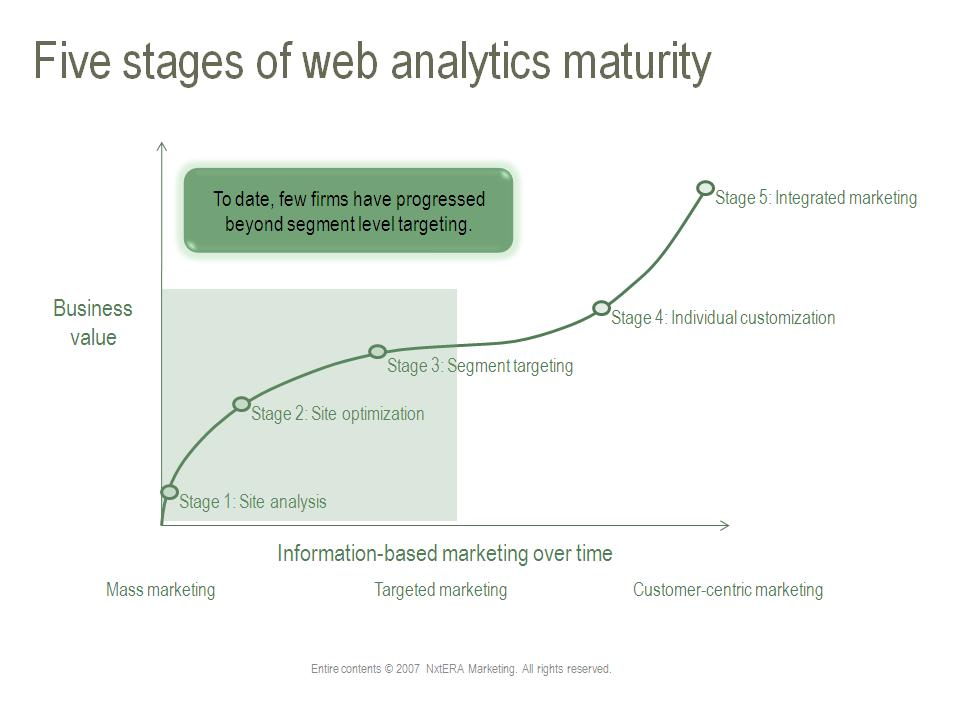In my post just before the holidays, I shared a framework to help marketers think about how web analytics contributes to data-driven marketing effectiveness over time. Marketers agree that they want to deliver more relevant and timely communications, establish a two-way dialog, and generally be more customer-focused and integrated, but many are struggling to make positive progress. Use the framework to understand understand the maturity of your data-driven marketing practices. Then define your objectives and timeframe for making incremental progress. In this post, I want to discuss how marketers can use their placement on the framework to define the key requirements for their web analytics tools. I work with an awful lot of firms out there that are not getting the benefits that they should be out of the technologies that they purchase. Why? Well, I think one key reason is that they are overly aggressive in their expectations of what they will achieve and over what time. The result is a lot of wasted technology — and wasted time.

If we were more realistic about what we are trying to achieve (i.e., the business outcome) with our web analytics tools then I believe our learning curve around how to effectively understand and leverage the data would actually accelerate. Why? Because we wouldn’t be constantly struggling with the technology. The free tools on the market are getting better and, while they are not sufficient for marketers that are beyond Stage 1 maturity, they will meet the needs of many. Here is a starting point to help you get beyond vendor eye candy and align functional requirements with business objectives:
Stage 1: Site analysis
Key questions you need to address:
- How many visitors are coming to my site?
- How are visitors using my site?
- How are visitors finding my site?
Core functional requirements:
- Visitor analysis
- Referrer analysis (pages and keywords)
- Strong library of parameterized “out of the box” reports
Comments on the market: These capabilities are table stakes to enter the web analytics market and most of the solutions out there do a reasonably good job here. Expect a more limited library of reports and more limited customization features from the free tools.
Stage 2: Site optimization
Key questions you need to address:
- How can I increase site visibility?
- How do content and taxonomy influence desired action?
- What would improve site navigation?
Core functional requirements:
- Path analysis
- Page and scenario drilldown analysis
- Drop-off analysis
- A/B and multivariate testing
Comments on the market: This is currently an area of focus for leading vendors in the market. The once-standalone optimization players – like Offermatica (acquired by Omniture), Kefta (acquired by Acxiom), and Optimost (acquired by Interwoven) – have been acquired and other vendors are looking to add these capabilities through acquisition or organic development. Given current client emphasis on customer experience management, expect this to continue to be an area of hot competition in the near future.
Stage 3: Segment targeting
Key questions you need to address:
- How can I logically group site visitors?
- How can I target visitor content by segment?
- How can I leverage site learning in other communication?
Core functional requirements:
- Segmentation model templates
- Ability to persist segments
- Ability to create dynamic segments and apply them historically
Comments on the market: Leading web analytics vendors like Coremetrics, Omniture, Unica, and Visual Sciences (acquired by Omniture) offer segmentation capabilities but this is an area where vendors differentiate.
Stage 4: Individual customization
Key questions you need to address:
- What is the best content for an individual based on prior site interaction?
- Should I reach out to an individual customer NOW?
Core functional requirements:
- Individual visitor profiles retained over time
- Ability to match profile to current visitor context – in real-time
- Ability to unify profiles when visitor identifies
Comments on the market: A few leading vendors are really just starting to focus here. Omniture’s recent acquisition of TouchClarity is a good example. Unica is also working on integrating it’s web analytics and campaign management modules in a meaningful way. But, overall, the vendors are just getting started at figuring this out.
Stage 4: Integrated marketing
Key questions you need to address:
- How are customers using online and offline channels in the buying process?
- How can I optimize online and offline interactions?
Core functional requirements:
- Calculate and retain key profile metrics
- Track metrics longitudinally
- Open data model and facilitation of extracts to other systems
Comments on the market: Today, you’re mostly at the mercy of your internal IT shop when it comes to the level of data integration sophistication required to help marketers in large companies integrate their activities across channels. Some firms call upon their interactive agency, systems integrator, or database marketing service provider to help. But, each approach has its challenges. It may make you feel better to know that no one has nailed this one and that gives us all something to aspire towards. At the end of the day, I believe that if the web analytics vendors want to be part of the solution then they need to hire (or partner) with database marketing gurus in order to make real progress.



